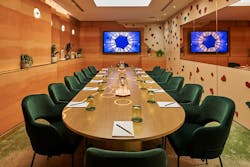How Biophilic Design Can Boost Productivity in Hospitality Meeting Spaces
Photo: The Hilton London Bankside AGORA Meeting Room features multisensory biophilic elements. Credit: Hilton Hotels.
Warm sun on the skin, big breaths of fresh air, multicolored flora and fauna eye candy – who doesn’t feel instantly rejuvenated after a few moments outside on a nice day?
Turns out, there are some scientific reasons for that. Research shows that interacting with nature can support physical, social and psychological well-being. This was recognized by The Global Wellness Institute, which named immersion in nature as a top global trend in 2019.
How you design a space can profoundly impact the meeting experience. And in hospitality, where the trend is to create a more unique space for each venue, bringing the outside in is becoming more common.
What is Biophilia?
Biophilia suggests that humans have an innate connection with the natural world. Biophilic design brings elements of nature indoors, using this connection to improve the well-being of those experiencing the space.
But it’s more complex than many may think, said Larry Traxler, senior vice president for Hilton Global Design.
“Simply putting a potted plant or a simple patch of moss on the wall is not enough to provide the lifting experience that many are seeking from this design philosophy,” he explained. “It’s important to note that biophilia should be multisensory. Well-orchestrated meeting environments with a biophilic focus should be immersive experiences that are relaxing, calming and sustainable.”
Air, lighting, greenery, and floor and furniture design that mimic natural landscapes all combine to improve the indoor experience.
Peter Scialla, president and chief operating officer of Delos, has done extensive research in collaboration with Mayo Clinic to study the effects of indoor environments on human health, which helped launch the Stay Well hospitality and meetings programs at select hotel properties.
[Related: Susie Frazier Makes Mental Illness a Corporate Priority]
“Delos Stay Well program was built off the growing body of evidence of the ways that key indoor environmental parameters impact occupants’ health,” Scialla explained. “Poor indoor air quality can contribute to health concerns such as headaches, asthma attacks, respiratory diseases and heart disease, as well as lower productivity by an estimated 6-9%.
“Recent scientific discoveries have pointed to the effects lighting has not just on our vision, but on our health, mood and performance,” he added.
To combat these negative effects of the indoors, Scialla turned to biophilia.
Biophilic Design in Meeting Spaces
When it comes to meeting rooms, the harmful effects of poor air and lighting, and uninspiring surroundings can take its toll on the overall well-being of people inside.
“People naturally gravitate toward representations of nature all around them. Artificial light and ‘beige box’ meeting spaces are often considered draining to folks who count down the minutes until they can get outside,” Traxler said.
Scialla noted some biophilic design features and their positive effects from Delos’ research. These include:
-
Active green walls: Living walls, constructed from plants or moss, bring the outdoors in to improve productivity and can also help remove contaminants from the air.
-
Lighting systems or natural lighting: Bright light during daytime hours can help promote productivity and alertness, in addition to increasing energy and better performance on cognitive tasks. Lighting systems that simulate natural sunlight or actual natural sunlight can help maintain circadian rhythm and improve energy, mood and productivity during meetings.
-
Purified air: Air purifiers, along with active green walls, that filter the air can increase the ability to focus and improve respiratory health.
-
Floor and furniture materials: Meeting rooms with patterned carpets or with floors and furniture that mimic natural elements like water and trees, such as wood or wood laminate meeting tables, can help enhance attention and task performance.
Hotel Meeting Rooms That Use Biophilic Design
For the following hotels, biophilic design is now a key focus when creating and improving existing meeting spaces.
MGM Resorts partnered with Delos to create Stay Well meeting rooms in its MGM Grand Hotel & Casino, Park MGM and The Mirage Hotel & Casino properties, and chief sales officer Stephanie Glanzer said her team has received tremendous feedback.
“Several clients have shared their post-conference survey results and attendees felt more focused and engaged during their meetings,” she said. “We find it can enhance the creative process, and when you’re attending a meeting or event, that is a very positive experience.”
Delos also works with Wyndham Hotels and Resorts and Marriott Resorts International on the Stay Well program.
Additionally, Traxler says that most of Hilton Hotels’ properties now incorporate biophilic design elements throughout common areas and meeting spaces. Some notable properties include:
- Hilton Hotel Munich City: This hotel is a plant haven, with live plants and plant-inspired imagery throughout the property, from its restaurant to meeting and event spaces.
- Hilton McLean Tysons Corner: Home to the “Innovation Gallery” space that can be used for meetings and presentations. Biophilic elements, including living walls, can be found in this space.
- Hilton London Bankside: The AGORA meeting room in this hotel features plants flanking the room, a wall meant to resemble rocks and the earth and a “push for creativity” button that releases a citrus scent into the air.
- El Conquistador Tucson: This 90-acre resort in Arizona features an interior that reflects the desert with colors, textiles and native flora inside the property.
Scialla also noted that biophilia’s restorative effects on health can be gained not only through real exposure to natural elements, but through virtual experiences, too. “Exposure to digital nature scenes for as little as five minutes have been observed to produce meaningful effects, such as improved recovery from stress when viewed during work breaks,” he explained, adding that some Stay Well meeting rooms feature decorative glass with nature patterns such as leaves or grass.
Science and Satisfaction
Science backs up the benefits of biophilic design, and Traxler adds that the genuine satisfaction reported by those who experience the spaces makes it a win-win strategy.
“We live most of our lives indoors, so bringing these natural elements into a place where we spend our working hours makes people happier, more focused and engaged,” he said.
“[Occupants] often comment on appreciating the ability to enjoy the feeling of more open space and recognize that being in this type of environment helps reset their senses and re-energize them during what typically is a long day of meetings.”
Read next: 6 Biophilic Trends You Should Consider for Your Next Interior Project
About the Author

